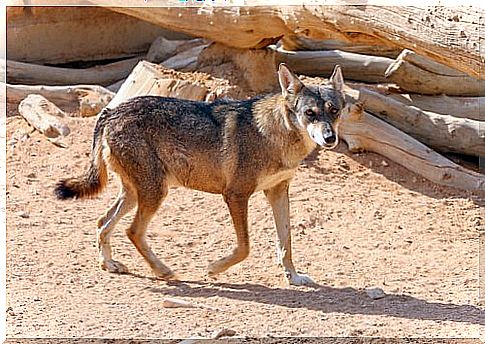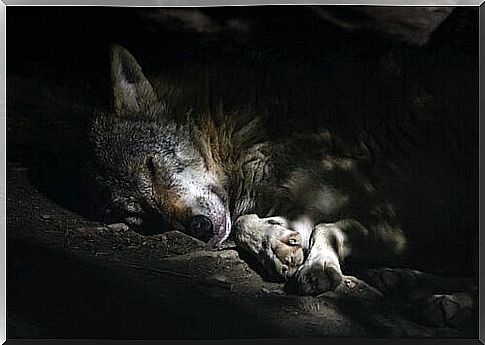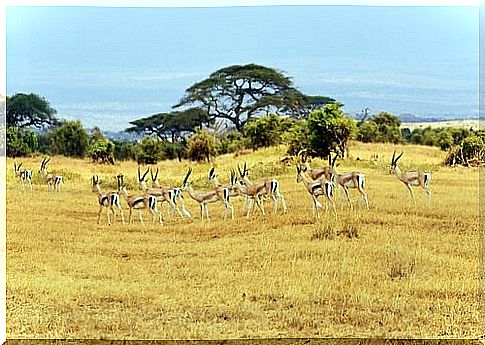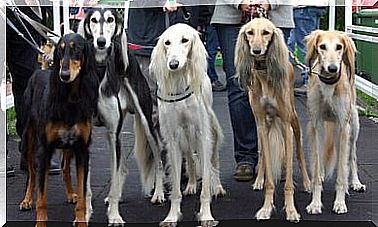Arabian Wolf: Characteristics, Behavior And Habitat

Among the different species of canis lupus , the Arabian wolf is one of the smallest that exists. As the name suggests, it lives and hunts in the Arabian Peninsula, although it also extends to several territories in North Asia. In this article we will tell you about this exceptional predator, showing you all the secrets of this fascinating cousin of the mighty gray wolf.
Arabian wolf: characteristics
Its scientific name is Canis lupus arabs and it is a subspecies of gray wolf. He is the smallest of the whole family, together with the Indian wolf. In fact, it measures just 66 centimeters at the withers, while its weight is around 20 kilograms. On the other hand, it has more developed ears, probably due to the evolutionary need to disperse heat. It is thought to be the result of crossing wolves and some gray wolves, although this theory has not yet been proven.
Like other canids, it has no sweat glands : to control its body temperature, it uses rapid panting, a system of domestic dogs.
Another outstanding feature of this animal is that the third and fourth toe pads are fused together. When he walks on the sand, he leaves a different footprint on other wolves of the same family, but this is something he has in common with the wild dog.
The coat is beige with gray tones, short and thin in summer, although a little longer on the back, to withstand solar radiation. In winter, the hair grows and the appearance becomes that of a normal mountain wolf.
Finally, it is striking that the Arabian wolf has yellow eyes and black pupils, although specimens with completely brown sclera have sometimes been sighted.
Arabian wolf: behavior and nutrition
Not much is known about this wolf’s habits because, on the one hand, it is rather elusive to humans and, on the other, because its population is increasingly decimated.

Unlike other canine species , this is the only wolf that never howls. The specimens of this species live in small herds and, in general, prefer to hunt only at night. The prey are chased by just two or four specimens, contrary to what happens in gray wolves.
In the summer they can dig sand burrows to protect themselves from the sun and to shelter the pups from the dangerous heat. They are quite territorial and often fight to defend their borders from invaders from other packs.
The diet of the Arabian wolf is mainly based on meat. Although, on certain occasions or in specific areas, this fascinating animal can adopt omnivorous eating habits . It feeds mainly on hares, rodents, desert gazelles, mountain goats, carrion, cats, but also on sweet fruits. They often attack farms, attracted by the smell of horses, goats and sheep.

If it cannot find food for several days, the Arabian wolf may decide to eat fish, look for snails, or even hunt small birds. As mentioned, in cases of extreme hunger man’s fear overcomes and approaches stables and sheepfolds, unfortunately triggering the reaction of the peasants. Also for this reason, there are fewer and fewer specimens of this wolf in the world. Bedouins and breeders do not forgive the interference of what, however, still remains a fearsome predator.
Arabian wolf: habitat and conservation
In ancient times, this wolf populated several areas of the entire Arabian Peninsula. However, it currently only lives in small areas of Israel, Palestine, Iraq, Yemen, Oman, Jordan and Saudi Arabia. Occasionally, small, sporadic groups have been sighted north-east of Egypt.
Due to hunting, the Arabian wolf has repeatedly been close to extinction. But, thanks to several conservation and captive breeding programs in the UAE and in the reserves of Oman and Israel, its population is gradually increasing.
To this must be added the ban on hunting in Oman, which has led to a slight recovery in the number of specimens and an expansion of the areas in which it lives. It is worth noting that this animal prefers to live in areas with little human activity, well away from villages and cities. We hope that the efforts made so far can secure a future for this beautiful wolf breed.









